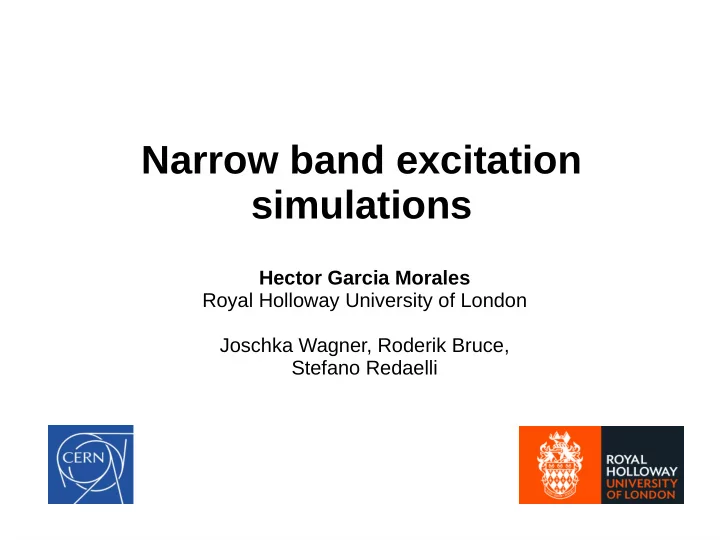

Narrow band excitation simulations Hector Garcia Morales Royal Holloway University of London Joschka Wagner, Roderik Bruce, Stefano Redaelli
Motivation Motivation ● Experimental results (presented by Joschka) look promising but not fully conclusive (yet). ● To fully understand the results we need to understand the physics involved. ● Tracking codes (MADX, SixTrack) would give a more precise description but the physics of the narrow band excitation might be difficult to extract clearly. ● A simple model with the minimum physics could give a better understanding of the principle.
Toy Model Toy Model Map with octupole Map with ADT kick
Matching octupole strength Matching octupole strength
Simulation set up and limitations Simulation set up and limitations ● Set up – Allows to run an unlimited number of turns and particles. (<1ms/turn/part) – Allows fixed and scan – Allows frequency scan in steps or continuously – ADT amplitude ramp up and down ● Limitations – No chromaticity – No other nonlinear effects – No repopulation – ...
Simulation results (fixed frequency) Simulation results (fixed frequency) ● Q(ADT) = 0.295 (as in promising result) ● Npart = 1e5 ● Turns = 5e5 (45 sec in real time) ● 1sigma (nominal) and 2sigma (blown up) bunches
0 turns 1e5 t 5e4 t 1.5e5 t 2e5 t 2.5e5 t 3.5e5 t 5e5 t 3e5 t
Final amplitude Final amplitude vs vs Initial amplitude Initial amplitude 1sigma 2sigma
Final amplitude Final amplitude vs vs Initial amplitude Initial amplitude 1sigma 2sigma
Particles lost Particles lost -Initial distribution -Particles which end beyond 5sigma
Losses and emittance Losses and emittance Emittance stays constant everywhere Not too many losses...
Simulation results (frequency scan) Simulation results (frequency scan) ● Q(ADT) = 0.290-0.295 ● Npart = 1e5 ● Turns = 5e3 (0.5 sec in real time) ● 1sigma (nominal) and 2sigma (blown up) bunches
Tail depletion Still some tail population Core affected
Initial vs final distribution Initial vs final distribution -Initial distribution -Particles which end beyond 5sigma
Losses and emittance Losses and emittance Although the core is clearly affected, the core emittance stays constant 1.8% particles lost (Not far from measurement results)
Conclusions ● The model shows some of the features expected from the narrow band excitation principle. ● Results for fixed frequency still not conclusive. Need to explore a bit more ● Results for frequency scan look promising but need to find a way to keep core unaffected. ● Complete simulation with toy model before using realistic tracking codes.
Recommend
More recommend